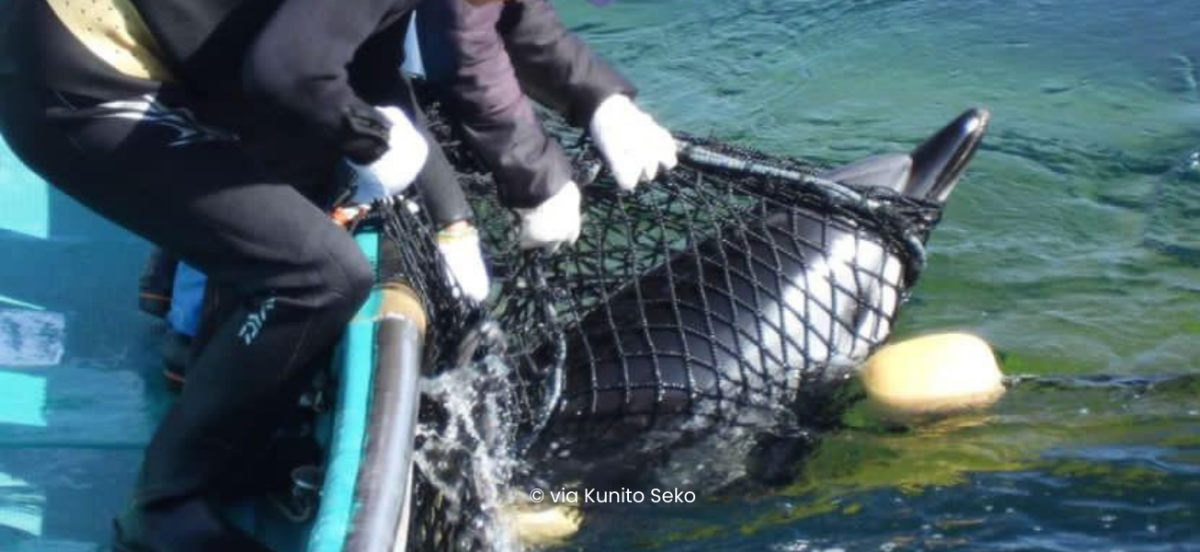Taiji dolphin hunts 2024/2025: A season of suffering
The Taiji dolphin hunt season has come to an end after 181 harrowing days. This year, 95 dolphins were captured, torn from their pods, and forced into a lifetime of captivity, while 289 dolphins were slaughtered for their meat*.
Among the most devastating statistics:
- 90 bottlenose dolphins were taken alive to be sold into marine parks.
- 289 dolphins were killed. Of these, 50 were Risso’s dolphins, 28 were Bottlenose, 157 were Striped, 31 were Melon-headed whales and 23 were Short-finned pilot whales
- 5 calves were abandoned in the cove, left without their mothers.
- 161 dolphins were held in the cove for at least one night.
Each year, these hunts continue because of the multi-million-dollar live dolphin trade. Captured dolphins are sent to marine parks in Thailand, China, and the Middle East, where they will endure years of suffering in confinement. The hunt itself is only the beginning – the true tragedy is what happens next.
Previously, we worked to disrupt the dolphin meat trade, shutting down a major dolphin meat supplier. This effort helped reduce the number of dolphins captured for slaughter, with a decrease of 24% this season versus last year. Unfortunately, the same cannot be said for those taken for captivity. This year, the number of dolphins captured alive for marine parks increased by 578%, fueling the global dolphin entertainment industry.
The captivity industry is fuelling the Taiji dolphin hunts
Each year, the Taiji dolphin hunts in Japan result in the capture and slaughter of hundreds of dolphins. While the killing in the cove is widely condemned, what happens to those taken alive is often overlooked. These dolphins, often young females, are sold into the marine captivity industry, where they will endure years of suffering in artificial enclosures.
Captured dolphins can be sold for over $100,000 each, making them far more valuable alive than dead. This trade fuels the continued hunting of wild dolphins. Thailand remains one of the biggest buyers of live-captured dolphins from Taiji, where they are forced into tanks and trained through food deprivation to perform in marine parks. Without demand from marine entertainment venues, the Taiji hunts would not be financially viable.
Inside the Industry: A Trainer’s first-hand account
The cruelty of the Taiji dolphin trade does not end in the cove. Our investigator in Japan recently interviewed a former dolphin trainer who worked at a facility in Taiji Town. Their account reveals the extent of suffering dolphins endure once they enter captivity.
- Dolphins are chosen based on market demand. Hunters prioritise young, female bottlenose dolphins for sale to marine parks, while older individuals and males are typically slaughtered for meat.
- Many dolphins die before reaching captivity. When new species like the Pantropical spotted dolphin were targeted due to declining bottlenose numbers, they proved too nervous to survive confinement—only two of ten survived one short boat transfer.
- The deaths continue long after the hunts. Dolphins frequently die from stress-related miscarriages, transport trauma, disease outbreaks, and inadequate care in marine parks. Some do not survive the flight to their new enclosures, while others succumb to force-feeding, contaminated water, or untreated injuries.
The full interview provides further insight into how aquariums and marine parks sustain the Taiji hunts.
Read the full interview here.
Tracking the dolphins: Where do they go?
Many of the dolphins captured in Taiji are transported to marine parks in Thailand, China, and the Middle East. Working alongside World Animal Protection, we have tracked the routes these dolphins take from capture to captivity. The findings are deeply concerning.
- Marine parks in Thailand continue to buy wild-caught dolphins despite public opposition.
- Dolphins endure long, stressful journeys in small water-filled crates with minimal care.
- Many do not survive transport due to extreme stress and poor conditions.
Our Waves of Profit report exposes the hidden supply chains behind dolphin captivity and the financial networks that sustain this industry.
Click here to read the report
Disrupt the Taiji dolphin hunts
Action for Dolphins is working to disrupt the live dolphin trade at its core. Our campaign is targeting the key players who enable this industry, pressuring them to cut ties with Taiji and stop profiting from dolphin exploitation.
Petition: To keep the momentum going to stop the Taiji dolphin hunts please sign our petition.
Pledge: Multi-million dollar marine parks around the world are not only profiting from this cruelty – they are driving it. Pledge to never attend any marine parks to help reduce the global demand for dolphins in captivity and hold marine parks accountable.
Donate: Every single dollar fuels our global fight to end the cruel trade of dolphins.
* Statistics taken from activist data at the cove and may not accurately reflect reported fisheries data
